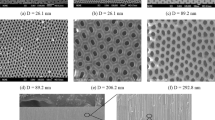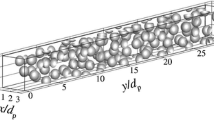Abstract
Low pressure gas percolation characteristic in ultra-low permeability porous media is investigated in this article through core flow experiments. The results show that the wall-slip layer covers more than 10% of the average porous channel radius on account of minimum pore size when the permeability is below 0.1 × 10−3μ m 2 order, and seepage behavior is contrasted to that in mid-high permeability pore media. When the gas pressure is not high enough, the flow regime turns into transitional flow instead of slip flow, and nonlinear relationship between the measured gas permeability and the reciprocal of average pressure exists. The gas measuring permeability experiment would be influenced by the non-linear relationship. If Klinkenberg-corrected method is applied to speculate the equivalent liquid permeability, the extrapolated value will become less or minus. Simultaneously, actual gas flow velocity at the outlet is beyond the calculated value with Klinkenberg formula. A new gas seepage model based on the general slip boundary condition is derived from the homogenization technique in this article. At last the flow model is examined to be suitable for representing the gas flow behavior in ultra-low permeability media and estimating the absolute permeability from single-point, steady-states measurements.
Similar content being viewed by others
Abbreviations
- b :
-
General slip coefficient
- b K :
-
Gas slip factor
- B :
-
Function of the gas molecule diameter and the absolute temperature
- C :
-
Function of the diffuse reflectance fraction
- D :
-
Molecular diameter
- G :
-
Macroscopic pressure gradient
- H :
-
Slip tensor
- I :
-
Unit tensor
- k :
-
Boltzmann constant
- Kg, K∞, K:
-
Gas, equivalent liquid, tensorial permeability
- Kn :
-
Knudsen number
- l :
-
Microscopic flow field characteristic scale or microscopic length scale of the pores
- L :
-
Macroscopic characteristic length scale of the porous media
- n :
-
Unit normal vector to Γ
- p :
-
Pressure
- p m :
-
Mean pressure
- r :
-
Mean pore-throat radius
- Re :
-
Reynolds number
- t :
-
Unit tangential vector to Γ
- T :
-
Absolute temperature
- v :
-
Gas velocity vector in the unit cell
- V m :
-
Measured flow velocity at the outlet of the core
- V th :
-
Theoretical flow rate by the Klinkenberg model
- \({V^{\prime}_{\rm th}}\) :
-
Theoretical flow rate by the new model
- V :
-
One-dimensional flow rate in the core
- x :
-
Dimensionless macroscopic space variables
- y :
-
Dimensionless microscopic space variables
- \({\varepsilon }\) :
-
Small fundamental perturbation parameter
- \({\varphi}\) :
-
Porosity of the sandstone
- η :
-
Viscosity
- Γ:
-
Internal surface of the unit cell
- λ:
-
Gas molecules average free path
- μ :
-
Viscosity
- Ω:
-
Unit periodic cell
- Ω p :
-
Pore volume in the unit cell
- ρ :
-
Density
- σ v :
-
Diffuse reflectance fraction
- ψ:
-
Physical quantity of gas flow
References
Bensoussan A., Lions J.-L., Papanicolaou G.: Asymptotic Analysis for Periodic Structures. North Holland, Amsterdam (1978)
Bird G.A.: Definition of mean free path for real gases. Phys. Fluids 26(11), 3222–3223 (1986)
Chen D.X.: Gas slippage phenomenon and change of permeability when gas flows in tight porous media. Acta Mechanica Sinica 34(1), 97–100 (2002) (in Chinese)
Florence, F.A., Rushing, J.A., Newsham, K.E.: Improved permeability prediction relations for low-permeability sands. SPE: 107954 (2007)
Hassani B., Hinton E.: A review of homogenization and topology optimization I-homogenization theory for media with periodic structure. Comput. Struct. 69, 707–717 (1998)
Hu G.Z., Wang H.T., Fan X.G. et al.: Mathematical model of coalbed gas flow with klinkenberg effects in multi-physical fields and its analytic solution. Transp. Porous Media 76, 409–420 (2009)
Karniadakis G.E., Beskok A.: Microflows and nanoflows fundamentals and simulation. Springer Science+Business Media, Inc., New York (2005)
Klinkenberg, L.J.: The permeability of porous media to liquid and gases. In: Drilling and Production Practice, pp. 200–213. API, New York (1941)
Sampath, K., Keighin, C.W. (1981) Factors affecting gas slippage in tight sandstones. SPE: 9872
Shen Q.: Get acquainted with rarefied gas dynamics. Mech. Eng. 24(6), 1–14 (2002) (in Chinese)
Shen Q.: Rarefied Gas Dynamics. National Defense Industry Press, Beijing (2004) (in Chinese)
Skjetne E., Auriault J.L.: Homogenization of wall-slip gas flow through porous media. Transp. Porous Media 36, 293–306 (1999)
Spurk J.H.: Fluid Mechanics. Springer-verlag, Berlin (2001)
Sun J., Li Z.X.: Molecular dynamics simulation on momentum accommodation coefficients of micro/nano gas flow. J. Eng. Thermophys. 29(6), 1014–1016 (2008) (in Chinese)
SY-T5336-1996, Method of core routine analysis (1996)(in Chinese)
Wang B., Mei H.Y., Zhang M.L.: Improved gas flow equation in low permeability reservoirs. J. Southwest Petrol. Inst. 26(1), 32–34 (2004) (in Chinese)
Wu Y., Cheng L.S., Ning Z.F.: New calculation method of Klinkenberg constant and non-darcy coefficient for low permeable gas reservoirs. Nat. Gas Ind. 25(5), 78–80 (2007) (in Chinese)
Xie C., Fan J.: Assessment of second-order velocity-slip boundary conditions of the Navier-Stokes equations. Chin. J. Theoret. Appl. Mech. 39(1), 1–6 (2007) (in Chinese)
Yang S.L., Wei J.Z.: Petro-physics. Petroleum Industry Press, Beijing (2004) (in Chinese)
Zhang G.X., Liu M.H., Zhang X.F. et al.: Continuum-based model and its validity for microchannel flow. Chin. Sci. Bull. 51(13), 1606–1612 (2006) (in Chinese)
Zhu G.Y., Liu X.G., Huang Y.Z.: A study of slippage effect of gas percolation in low permeability. Nat. Gas Ind. 27(5), 44–47 (2007) (in Chinese)
Zhu X., Xin M.D., Q. L.: Analysis of gas flow in microchanel of arbitrary shape in slip flow regime. J. Chem. Ind. Eng. (China) 54(7), 902–906 (2002)
Author information
Authors and Affiliations
Corresponding author
Additional information
Fund project: National science and technology key special project “Development of large oil and gas fields and coal bed gas” (2008ZX05009).
Rights and permissions
About this article
Cite this article
Xiang’an, Y., Haoguang, W., Lijuan, Z. et al. Low Pressure Gas Percolation Characteristic in Ultra-low Permeability Porous Media. Transp Porous Med 85, 333–345 (2010). https://doi.org/10.1007/s11242-010-9565-0
Received:
Accepted:
Published:
Issue Date:
DOI: https://doi.org/10.1007/s11242-010-9565-0




